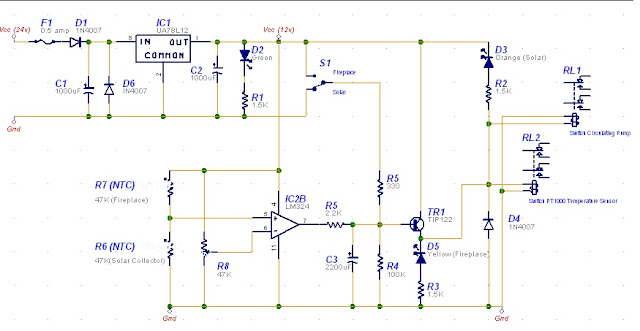Earthing
In Malta (and I assume in most, if not all countries), earthing is mandatory. This is provided by the mandatory earth electrode which must be located next to the power meter. For redundancy sake, I have added a further two earth electrodes, all installed (dug) in different locations. In fact the additional electrodes have been installed in the yard. All the electrodes are interconnected using 6mm copper cable to maintain the same earth potential.
A 10mm cable runs from the electrodes to the roof were I have all the photovoltaic panels, panel structures and wind turbine earthed.
To protect all my house electrical and electronic equipment, I have constructed a number of lighting protection circuits. These are;
1) Circuit to protect my mains supply - 240v AC 50Hz, being supplied either from my local power provider (Enemalta) or from the inverter.
2) Circuit to protect my 24v DC house wiring system.
3) Circuit to protect power from the 'off-grid' panels feeding the batteries and off-grid inverter.
4) Circuit to protect power from the 'grid-tie' panels.
1) Circuit to protect my mains supply, being supplied either from my local power provider (Enemalta) or from the inverter.
The basic and most important component is the Varistor, and in fact I have used quite a number of them.
Surge protection is provided between;
a. Live <--> Neutral. This is the most important and in fact most electronic equipment will be already protected internally using a similar setup.
b. Live <--> Earth. This is also very important to protect since the potential difference between Neutral and Live should be close to the potential difference between Live and Earth.
c. Neutral <--> Earth. The voltage difference between Earth and Neutral should be close to 0 because the Neutral is actually earthed at the distribution centre. However a small potential difference does exist (<10v) and this protection is intended to safeguard in case the Neutral potential is raised with respect to the Earth.
Components List
SA1, SA2: Miniature Gas Filled, 20kA/20A
C1, C2, C3: 150nF 300v AC Capacitors
RV1-RV5: 300v Varistors
RV6-RV10: 300v Varistors
RV11-RV15: 30v Varistors
D1: Green LED
R1: 150K 0.25w
2) Circuit to protect my 24v DC house wiring system.
The below circuit is used to protect against any surges which might get through to the DC system (batteries, off-grid inverter, house lights etc). Protection is mainly provided by the varistors, however diodes D1 and D2 are connected in reverse polarity across the supply to protect against any back emf.
Components List
C1: 100nF
C2: 4700uF 50v
RV1-RV5: 30v Varistors
D1: Green LED
R1: 1.5K 0.25w
D2, D3: 10Amp Diodes
3) Circuit to protect power from the 'off-grid' panels.
This circuit sits exactly under the off-grid panels and serves as the primary protection to my DC system against any voltage surges/spikes.
Components List
C1, C2, C3, C4: 4700uF 50v
RV1-RV2: 50v Varistors
D1, D2: 10Amp Diodes
F1, F2: 5 amp fuses
4) Circuit to protect power from the 'grid-tie' panels.
This circuit sits exactly between the grid-tie panels and the grid-tie inverter. It was not really necessary because this type of circuit already exist internally in the inverter however I wanted to provide extra external protection. I prefer this circuit blowing up then my expensive SMA inverter!
Components List
C1: 470uF 400v
C2: 100nF 1000v
RV1-RV3: 360v Varistors
D1: 10Amp Diode






















